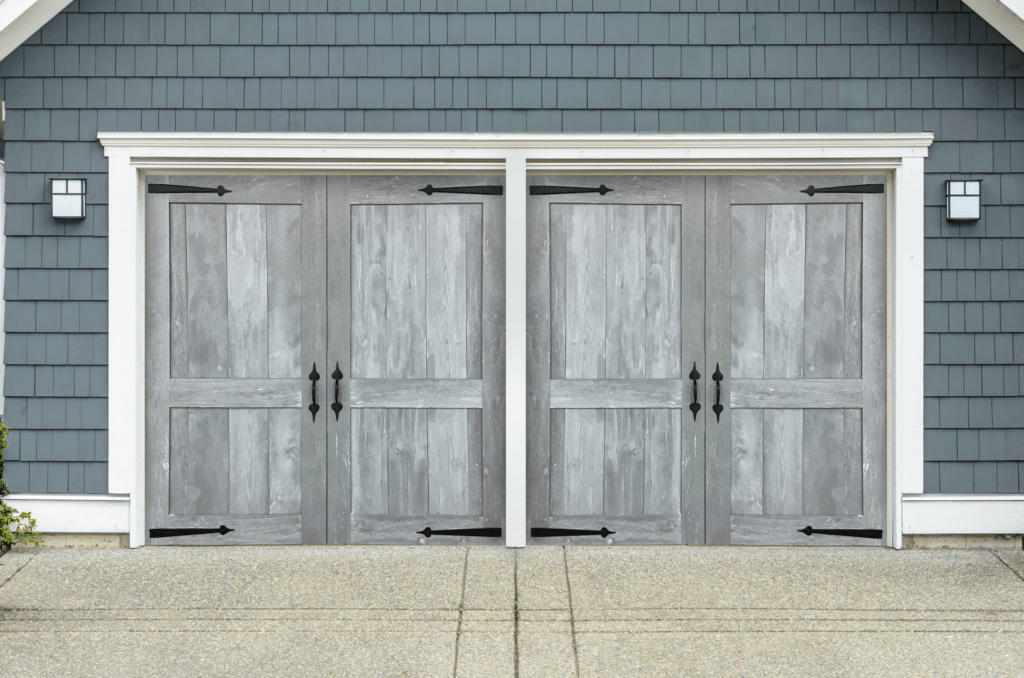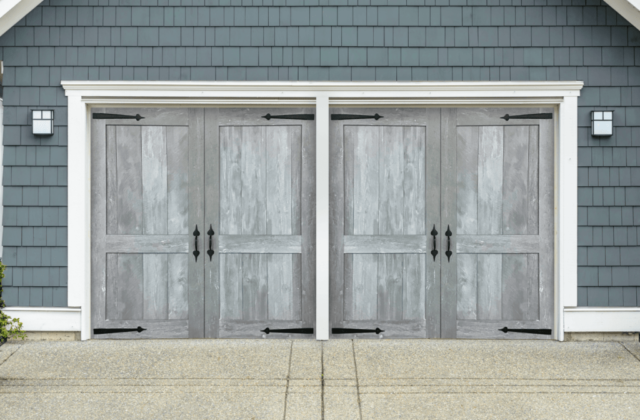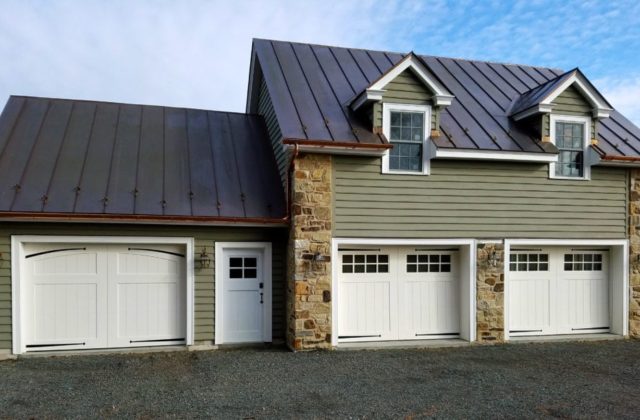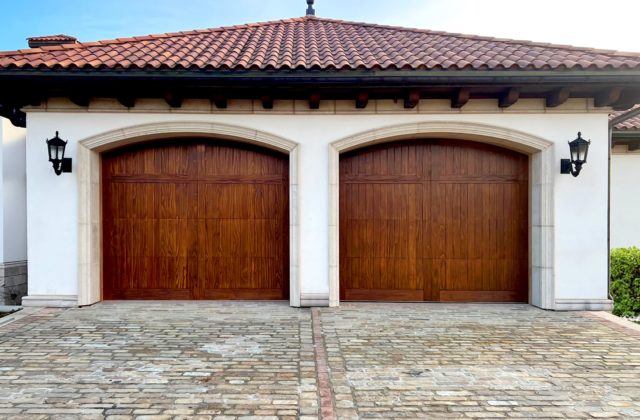No matter what window detailing, decorative hardware, or rich finish you put on your overhead garage door, it all starts with the materials you choose for garage door construction. Choose the wrong materials and you can end up spending unwanted time and money on ongoing maintenance or you may need a replacement door much too soon. In our garage door materials guide, we’ll cover all the garage door materials we use.
Best Garage Door Materials to Look for When Purchasing a New Door
At Artisan, we construct our carriage-style garage doors using four top-of-the-line materials:
Wood
Wooden garage doors are constructed of high-quality wood species, adding warmth and beauty to your home’s exterior. Artisan’s wood garage doors are designed with rich detailing and styling.
Wood Composite
Using long-lasting, engineered wood products, this wood-fiber-based material combines the strength of heavy-duty, non-wood materials and adhesives with the rustic, traditional look of genuine wood. It offers moisture, rot, and insect resistance, and can be finished with paint.
Vinyl
As a wood alternative, vinyl garage doors are highly durable and require less maintenance. Vinyl materials are moisture-, salt-, and insect-resistant.
Composite
Composites utilize urethane-based, pre-primed, faux-hardwood materials that are molded into subtle wood textures and patterns. The result is a lightweight garage door that minimizes the need for painting.
Learn more about wood, vinyl, and composite garage door materials so you can make an educated decision when spending money on improving your home.

Wooden Garage Door Material
Wood Species Options
Because there is such an abundance of wood species to choose from, selecting a wooden garage door can be intimidating, but it doesn’t have to be! When picking out your wood type, it is important to consider unique characteristics, color ranges, and grain patterns. Be sure to also keep availability, garage door size, and price in mind to ensure you stay within your desired budget. Our most popular wood choices are:
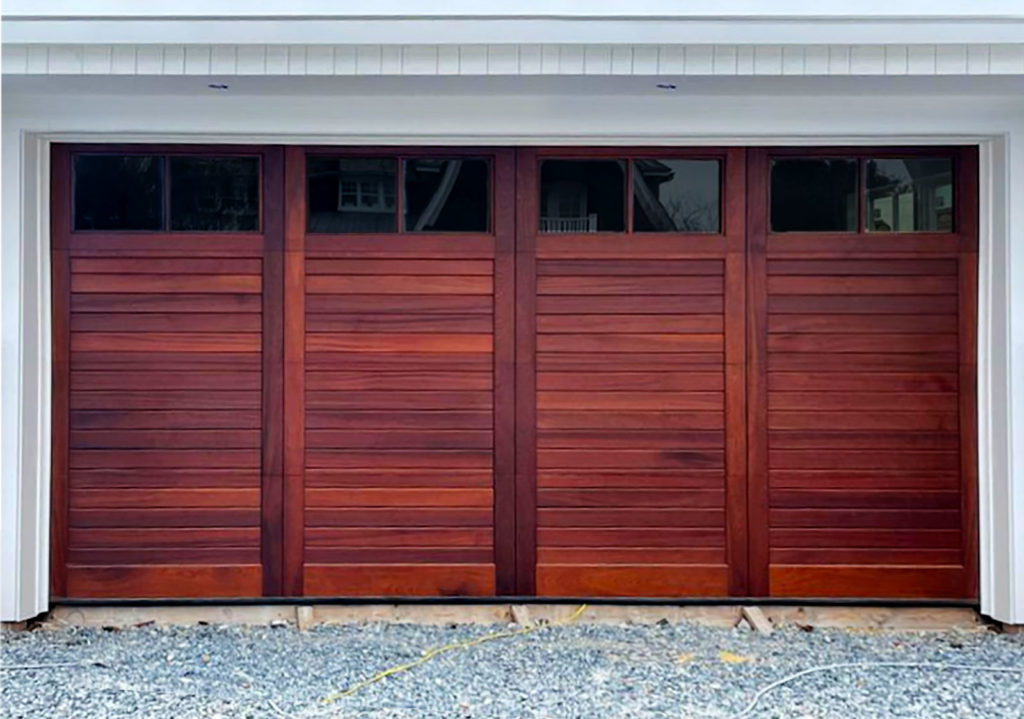
Red Grandis
Red Grandis is a versatile, fast-growing hardwood from the Eucalyptus tree that is native to coastal Australia. It is a premium-quality hardwood that is consistently stable, an excellent exterior hardwood, and has the ability to hold paint well.
This renewable hardwood is relatively uniform in color with slight variations from pale to medium pink. The attractive, moderately-coarse grain pattern is predominantly straight, but in some cases may be slightly interlocked. It is similar in hardness, density, and grain texture to mahogany and cherry. The heartwood is durable and resistant to insects.
Western Red Cedar
Western Red cedar is native to the Pacific Northwest US and Canada. The soft red-brown timber has a tight, straight grain and few knots. It is valued for its flexibility, strength in proportion to its weight, distinct appearance, aroma, and its natural resistance to decay. It is extensively used for outdoor construction.
Its rich coloring ranges from a light straw color to a reddish- or pinkish-brown, often with random streaks and bands of darker red/brown areas in the heartwood. It is a stable wood but it tends to be soft, making it prone to dents and scratches. It seasons quickly, has a low shrinkage factor, is free of pitch, and has excellent finishing qualities.
Spanish Cedar
The heartwood of Spanish Cedar varies in color from pinkish- to reddish-brown, when first cut. The color darkens as it ages to a deep reddish-brown and sometimes displays a purplish tinge. The sapwood ranges in tones from white to pinkish-white. The grain is prominent and usually straight, but sometimes appears interlocked. The wood texture ranges from fine and uniform to coarse and uneven, with a medium luster.
Spanish Cedar produces a distinctive odor and is often oily on the surface. It is a strong hardwood with soft to medium density. Spanish Cedar is highly resistant to decay, fungi, and termites, making it good for interior and exterior use.
Sapele Mahogany
Sapele is an imported hardwood and is found in lower tropical rain forests and tropical semi-evergreen rain forests throughout Africa. Sapele heartwood is medium to dark reddish-brown with a medium texture and high luster. Sapele is very similar to African mahogany, with a fine, interlocked grain. It may also yield a wavy grain that produces a distinctive roe figure on quartered surfaces. Sapele heartwood stains well and is suited to an array of finishes, retaining its color over time.
Douglas Fir
Douglas Fir is the strongest of British Columbia’s family of fine softwoods. It is characterized by its distinctive natural attributes of strength, stiffness, durability, and beauty. It also accepts a variety of stains and finishes with a clear, tight, straight grain.
The narrow sapwood is light in color, while the wider and more durable heartwood ranges from yellowish to reddish-brown, leaving an overall golden-orange appearance. Spring and summerwood have a pronounced difference in color. Summerwood has darker and more sharply defined bands. This difference in color results in a distinctive grain pattern when the log is flat-sawn.
Federal Stewardship Council Certification
The Red Grandis wood used in much of our garage door manufacturing is Forest Stewardship Council® (FSC) certified by an independent third party. This means our wood is certified at each stage of the production chain on the basis of environmental, social, and economic requirements. This ensures that the lumber we purchase:
- prevents overlogging
- protects at-risk species
- preserves rivers and streams
- minimizes erosion from roads
- conserves vulnerable habitats
- supports community rights
Finish Options
Stain-grade and Paint-grade Garage Doors
Most wood species are beautiful when stained. However, the natural colors and pattern variations impact the final appearance. It is always best to test your stain color on the wood to ensure it meets your color expectations. Solid wood doors are suited for any kind of finish, whether it be paint or stain. It’s recommended that wood composite doors only be painted to achieve the best results. When choosing wood material for your garage door, remember this tip:
A stain-grade door uses woods that will look beautiful when stained or painted. A paint-grade door uses inferior stain-quality woods or wood composite materials suitable only for paint finishes.
If you are undecided on how you will ultimately finish your garage doors, opt for a stain-grade door to ensure you have the most finishing options to choose from when the time comes to make the final decision.
Stained Doors
A stain will bring out the natural beauty and color of any wood product. Artisan uses EnduraFinish stain, a 5-step polyurethane wood coating system, which produces the look and feel of a furniture-quality finish on wood garage doors.
Painted Doors
Garage doors should be primed on all sides and edges and then painted using a high-quality, exterior-grade latex paint. Most paint manufacturers can color match any paint color you choose. However, keep in mind that darker colors tend to fade faster than lighter colors. Dark colors placed in locations with direct sunlight will require more maintenance over time.
Vinyl vs. Composite Garage Door Materials
Vinyl and composite are both popular wood-alternative materials used in home exterior building projects such as garage doors, decks, and fencing. But how do the two materials differ? Vinyl is a solid plastic that is free of any wood materials, while composite items combine wood pulp and plastics or light-weight, urethane-based materials and adhesives. While both vinyl and composite doors offer easy upkeep and maintenance, there are some differentiating factors between the two garage door materials.
Vinyl Garage Material
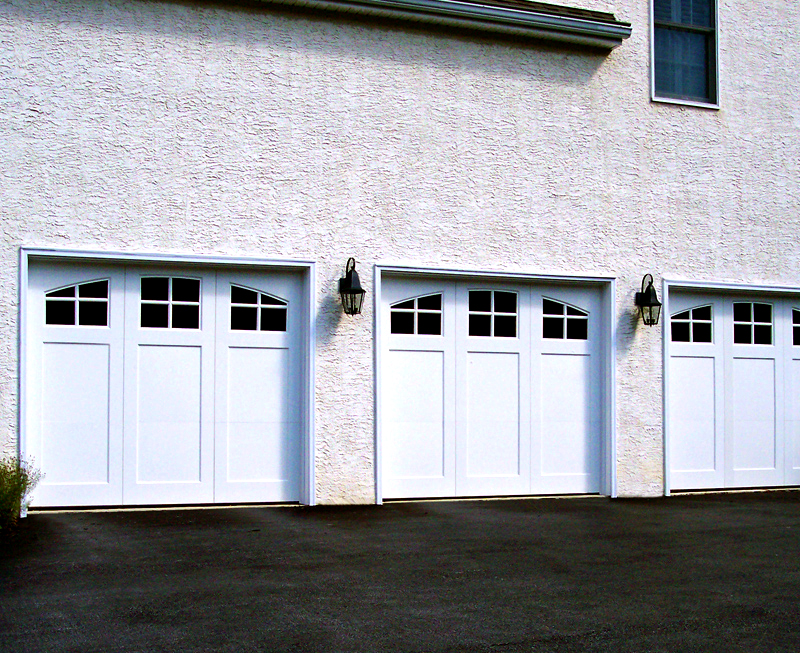
Using Cellular Vinyl
Cellular PVC is a wood-replacement material commonly used in garage door construction. Cellular PVC has most of the good qualities of real wood, but fewer of the maintenance requirements. While it can cost more than wood, this product will not splinter, twist, or warp. It is resistant to insects and salt, and is impervious to moisture.
Finish Options
Thanks to its moisture resistance and durable, semi-matte finish that adds protection from scratches and dents, there’s no need to paint PVC for added performance. However, if you’re looking to alter the semi-matte finish or white coloring, a 100% acrylic paint can be used on the surface once properly prepared. When painting cellular vinyl, it’s important to choose paint colors with a Light Reflective Value (LRV) of 60 or higher (generally lighter colors) to reduce excessive heat being absorbed from the sun. If a homeowner prefers a darker paint color, we recommend not using vinyl as the garage door material.
Composite Garage Material
Composite garage doors use wood fibers and strong, non-wood materials for an extremely versatile final product. Wood composite items are popular since they can be manipulated and formed using traditional woodworking methods. Other composite materials can offer different benefits depending on how they are used. For example, urethane composite doors are very light in weight and can handle the high-heat temperatures that can occur from direct sunlight.
Types of Composite Materials
Tricoya® Wood Composite
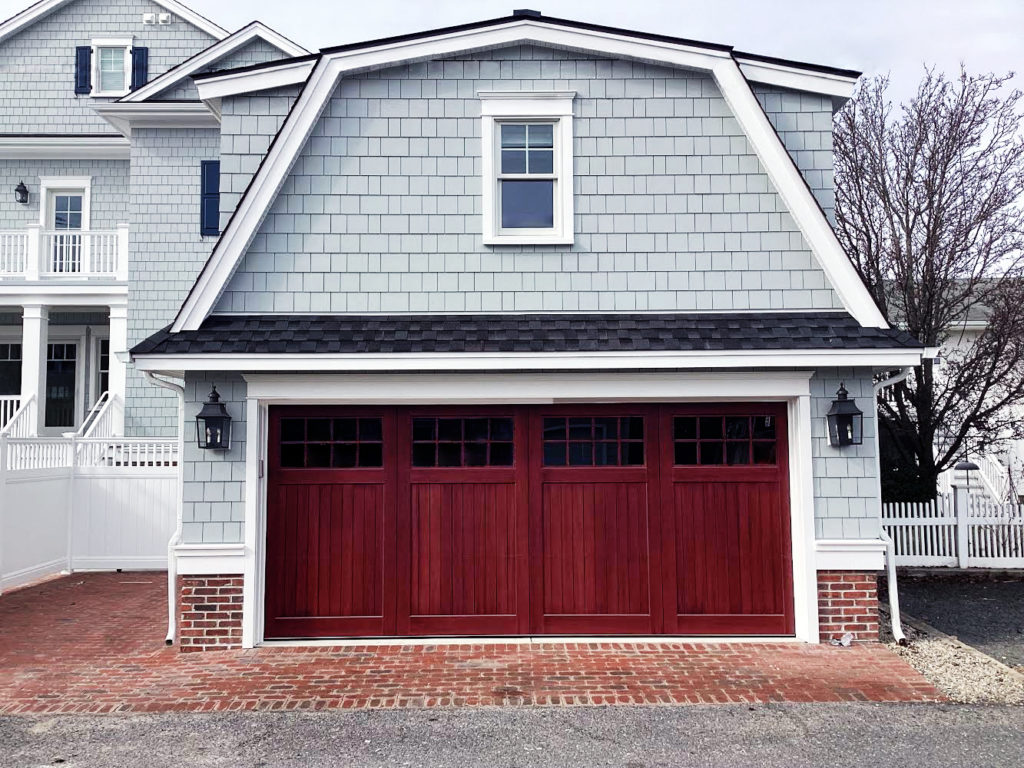
Tricoya composites are wood fiber-based, MDF-alternative products that are manufactured using a new process that is widely recognized as the gold standard for creating high-performance wood composite products which can be used in extreme weather conditions. Tricoya® panels combine the stability and durability of non-wood materials with the advantages of a MDF wood composite, including sustainability, versatility, lightweight, and ease of installation, coating, and forming.
Additionally, Tricoya®:
- is resistant to fungal decay
- is FSC certified and sourced from sustainable sources
- is non-toxic at its end of life
- has an extended service life of 25 years for above ground exterior use (significantly longer than Extira and MDF)
- has the manufacturing flexibility of MDF and wood
- has lower maintenance costs because of extended periods between exterior coating maintenance
Extira® Wood Composite
Extira®, another wood-based composite, performs two-times better than wood or MDF and is great for exterior applications. The panels may look like MDF, but they don’t behave like it. With its different ingredients and patented and proprietary manufacturing process, the panels offer superior performance. Extira® is easy to work with and can be carved, routed, and machined. This building material resists moisture, rot, and termites, and boasts a 10-year warranty for quality assurance.
Urethane Composite

Urethane is a polymer that can be used to make wood-textured, molded millwork products and is becoming well-known as a popular alternative to traditional wood products. Urethane composites can take on the appearance of wood, but will outperform wood every time thanks to its light weight and superior moisture, rot, and decay resistance. Paint adheres to the surface extremely well, helping to limit maintenance requirements. Urethane composite materials are also engineered to handle extreme temperature fluctuations, providing them with the ability handle dark paint colors in direct sunlight without fading or warping.
Finish Options
Wood composites have a smooth, flat surface finish and are best painted. Keep in mind that wood composites may also be used with solid wood but composite will not stain well, so paint is the only true option to produce an immaculate overall look.
Urethane composites are also painted. However, urethane composites are typically molded with a wood grain texture. The faux stain paint finish that we utilize is a paint but undergoes a multi-step process to create a final product with a real, stained-wood look that mimics true mahogany, oak, walnut, cherry, and driftwood.
Unlike vinyl that absorbs the sun’s heat, wood and urethane composite materials minimize solar heat gain. This means that you are not limited to light colors on your garage door and you have the ability to choose standard paint or faux-stain paint in any color you wish.
